Back in the day, I was known as the “goat blogger”…
…thanks in part to my Goat 101 series and our small herd of extremely hard-to-contain dairy goats.
But as I drifted away from the world of goatiness (hello big beautiful Brown Swiss milk cow!), I’ve found myself taking on a new identity:
“That mulch garden girl”
Yup. That’s me. And I’m happy to claim it.
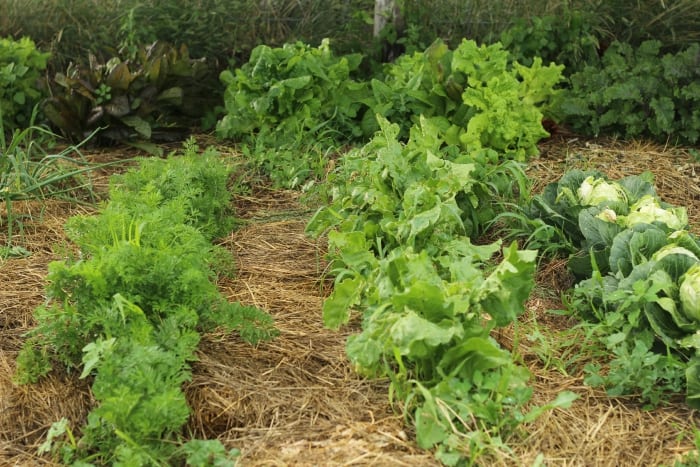
I won’t go into the back story of how I got into the whole mulch thing because you can read all about it here, but needless to say, I’m going on my third year of heavy mulch, and don’t plan to go back to bare dirt gardening anytime soon.
In my garden, deep mulching has:
- Cut my weeding time down to almost nothing
- Reduced the amount of water my garden requires
- Reduced the frequency I have to water
- Improved my soil (there are worms everywhere now!)
- Helped me fall in love with gardening again
Even with all those benefits, inevitably when I start talking about spreading mountains of hay on my garden, I get a number of folks who think I’m slightly insane. Not that I blame them or anything– it does look rather bizarre at first. And then after the sideways glances fade, the questions come…. Through email, through Facebook, through blog comments, you name it. You wanna know the details, and that’s good, because that’s why I’m here.
If you want the FULL scoop on the plan, purpose, and process of deep mulch gardening, you definitely want to grab my free mulch ebook– it includes pictures and ALL the details.
But today I’m specifically going to answer some of the most common objections and questions I get regarding this unorthodox method. If you’ve been considering this method, hopefully you’ll find the As to some of your Qs below:
Deep Mulch Gardening FAQs
Q: Do I need to worry about using organic hay?
A: I wouldn’t necessarily worry about getting certified organic hay. However– you need to be 100%, absolutely, positively certain the hay you are using has NOT been sprayed with herbicides. Read my sad story about this here.
Q: You say to mulch with hay. Won’t this introduce hay seeds into my garden and result in a whole lot of unwanted grass?
A: As long as your mulch layer is thick enough (at LEAST 8 inches), you should NOT have problems with hay seeds. If you do end up with a thin spot and grass poking up, simple cover with more hay. I can’t stress enough how important it is to have a deep enough layer, though.
Q: I’m still worried about hay seeds. Can I use straw instead?
A: Sure! I prefer hay since it is easier for me to obtain, but straw will work too. You can also use leaves or really any mulching-type material you have available.

Q: Have you heard of the Back to Eden method? Why don’t you use wood chips instead?
A: Yes, I am very familiar with the Back to Eden method and love the concept. There are a few reasons I chose to go with hay mulch rather than wood chips:
- Hay is much more readily available to me in our local area
- I have heard from a few people who tried the Back to Eden method with sketchy results. I suspect this may have something to do with the nitrogen content in various soils or how long the garden had to age and mature. I personally was nervous about hauling in loads of wood chips, dumping on the garden, and then having to remove them all if it didn’t work like I had hoped.
- This post written by a fellow homestead blogger sealed the decision for me.
Q: Doesn’t the deep mulch attract lots of mice or rodents?
A: I personally haven’t had mice issues in my garden, but maybe that’s because they are all in my house… In all seriousness though, I have yet to find evidence of mice tunnels or nests in my mulch, even though I have plenty of mice in the barn, chicken coop, and yes, house.
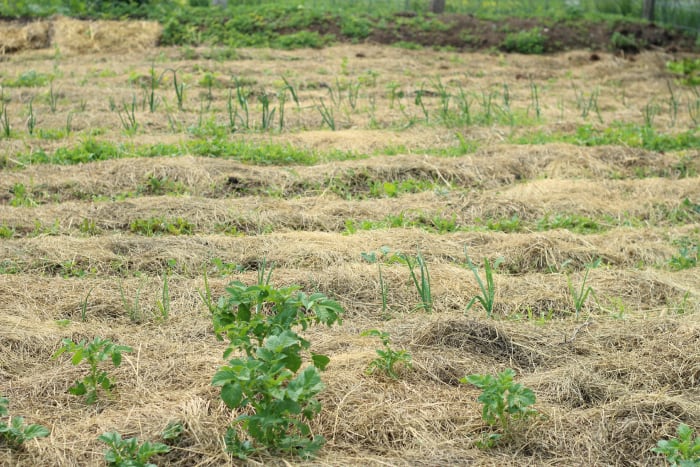
Q: Does the deep mulch attract lots of snakes?
A: We have a decent population of bull snakes and rattlesnakes in our area, but I have never had issues with them in the garden. I do suspect our free-ranging chickens help to deter them from around our yard/barn area, so maybe that plays a part.
Q: What about slugs and snails?
A: I get this question a lot, but unfortunately don’t have an answer since we don’t really have slugs or snails here in Wyoming. If you do deep mulch in an area with slugs, I’d love for you to let me know your experiences!
Q: And voles? Do you have vole problems?
A: I wish I had a clear answer for this, but voles are not prevalent where we live, so I have not had experience with them in a garden or otherwise. Sorry!
Q: What about moldy hay? Can I use that?
A: You bet. Rotten hay will work just fine. Just be cautious when handling or spreading moldy hay and be sure to wear a dust mask, as that stuff can really mess up your lungs.
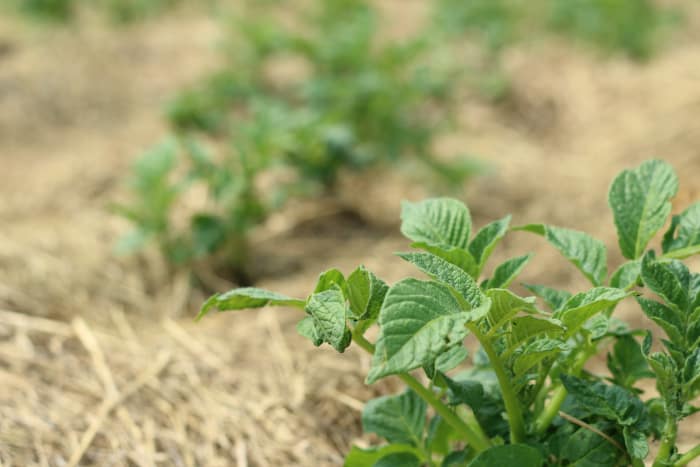
Q: Do you have to remove the hay so you can till in the spring?
A: I’m going on my 3rd year of deep mulch and the rototiller is still sitting in the shed collecting dust. Last year and this year I have planted with zero tilling. I simply pulled back the mulch, “roughed up” the dirt in the row with a hoe or a stick, and planted as usual. The mulch kept the soil soft and wet– no tilling required.
Q: What about fertilizer?
A: The rotting/decomposing hay will provide some nutrition and organic matter for the soil. Beyond that, the Queen of the Deep Mulch method, Ruth Stout herself, used cottonseed or soybean meal to fertilize. I personally prefer not to use cottonseed or soybean meal, so I have been amending rows with finished compost as needed. So far, so good, but I plan to keep experimenting with this. Stay tuned…
Ready to jump on the deep mulch train and cut down your garden chores drastically?
Download my free Deep Mulch eBook!
Other Deep Mulch Posts:
- How to Start a Deep Mulch Garden
- Deep Mulch Garden: Wrap Up
- Deep Mulch: Year Two
- Deep Mulch Video Update
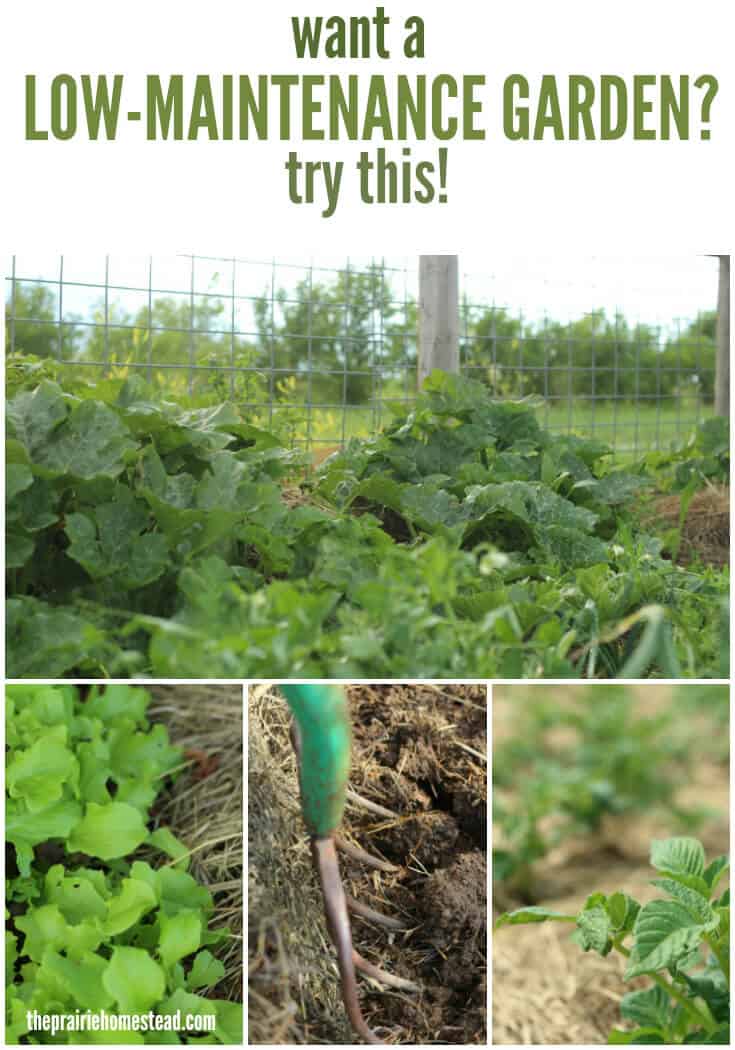

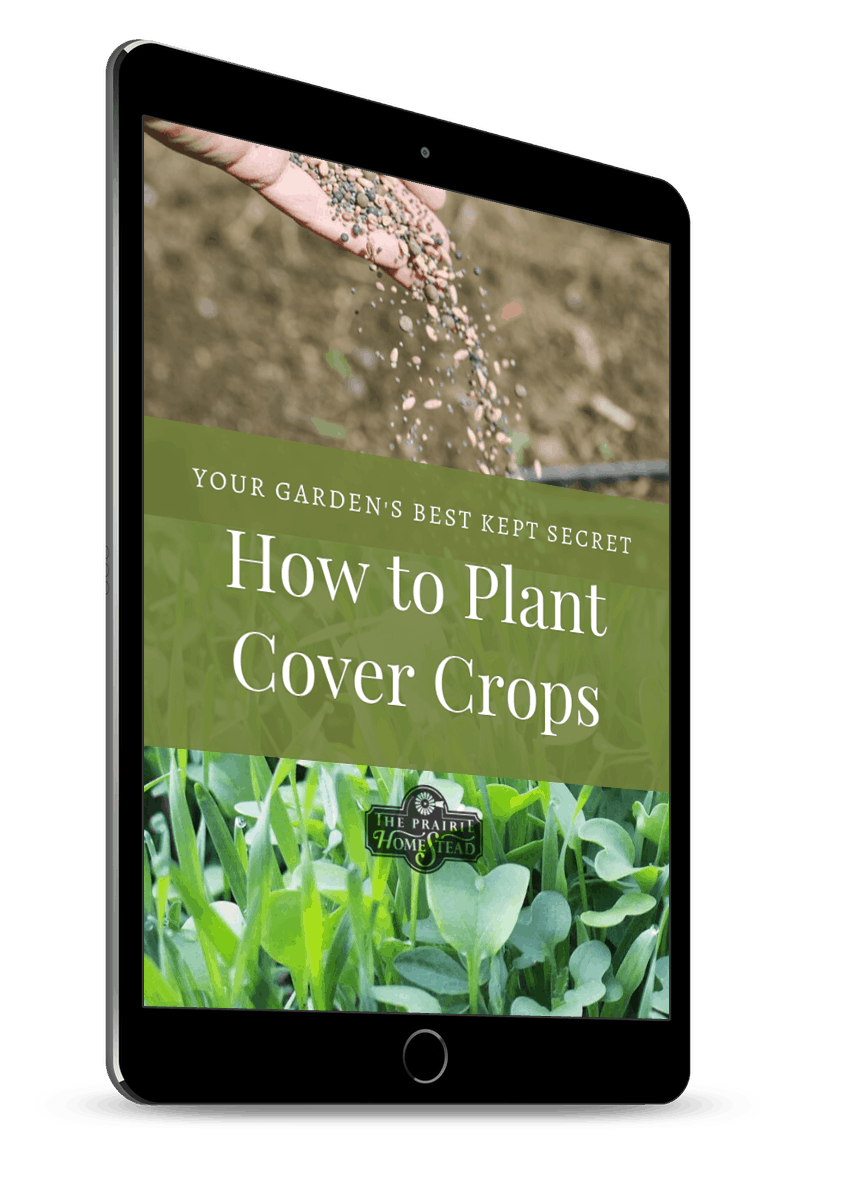

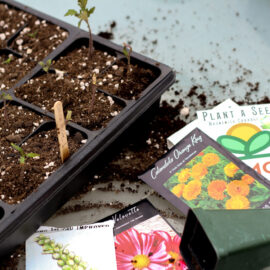
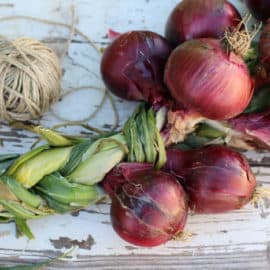

I LOVE your gardening method!
It works great out in the HOT Arizona desert (Like 120 degree highs). Deep mulching makes it so I can water less and easily keep on top of the weeds! 😉
I started mulch gardening (because of your posts) not long after the last post of your three part series…and have loved it ever since!
I am SO glad to hear this Julia! And thrilled to know it works in the desert, too!
I’m in rainy/wet Oregon and have found my super thick layer of mulch decomposes rapidly. So much so that it is completely GONE by spring time. I’d be curious if this method works better in some climates than others? I love the concept, but a bit wary of how much hay I would need to re-apply throughout the year to make it worthwhile. We always mulch with hay around the plants during growing season to conserve moisture and help keep weeds at bay – it would be nice if I could figure out how to use it year-round without using 10+ tons of hay! 🙂
I’m in Southern Oregon, and we’ve been using a combination of hay, grass clippings, straw, wood chips and whatever else we can get. More like a lasagna bed. But, we are doing it more to build up our soil as we are in an ancient riverbed and grow more rock than anything else. We have to same problem of the beds covered in hay needing to be redone before we can plant. We even deep mulched our chicken run/orchard. The mulch is gone, and our trees are the most loaded I’ve ever have seen them. And for the first time in several years I haven’t had to fight fire blight.
That’s a great way to build up the soil! Thanks for sharing about the fire blight. We just put in an orchard, so I will keep that in mind.
I’m thinking if we want to do the deep mulch method we’ll need to re-apply 3 times per year (fall, late winter & after planting). If we apply at the same rate we tried last fall (1 ton for ~400sq ft), it would work out to be about 45 tons to do our entire garden for the year. Yikes. If I can supplement with large quantities of manure & leaves and such, hopefully that will cut down on some of the hay usage but still give great results.
After just a couple years we are starting to build up some top soil. Maybe a time will come when I won’t have to start everything in soil blocks. It gets tiring making 100’s of soil blocks just to grow a garden.
Whew! It will come eventually! Have you considered raised beds?
How do you handle the wild berry vines coming up any where there is planting/watering? We are new to OR, from CA, and feel that in-ground gardening is impossible here. We are currently doing a lot of container gardening till we figure this thing out with the wild berry brambles. Help!!
Berry vines can be a nuisance for sure! We dig out the roots the best we can (and burn all the parts!) and till deeply (12″) and then dig up any that we see coming up. It takes a couple of years being consistent to get a particular spot cleared, but it’s totally possible. If you are starting with a huge patch of pure brambles, you may need to consider hiring someone to help you get a start on it. We have 1/2 acre veggie garden (plus orchard and berry fields) and have found consistency to be the best option for us. We don’t use chemicals on the property. After 3 years, all but a couple very stubborn vines are gone and we have our veggie garden in the ground. Best wishes to you!
I have been using this method for several years after reading Ruth Stout’s books. I will never go back. I do have to say though, in my area we do have slugs and snails and they love the mulch. It is a constant battle…so far I am the winner! I hate slugs! ?
I have been wanting to try this method but I already have such a problem with pill bugs eating everything I am afraid the damp underneath side of the hay will make them worse. Does anyone know how to deal with them organically?
Actually my experience is that pill bugs prefer to eat the decomposing mulch and will not bother intact plants and fruit when they have the mulch to live in and eat they are part of the ecosystem of mulch gardening.
Hi Terry,
I am trying deep straw mulch for the first time this year and the slugs nearly destroyed my pepper transplants the first night they were out in the garden! Leaves all eaten. So sad. What have you done to beat back the slugs?? I need wisdom! Thanks. 🙂
I run my chickens in my garden in the fall and winter for starters….no bugs. But I live in Mist…thats right, very wet. Hand picking the few slugs I get is my control. Using scissors, I stroll through my garden at night and early morning….snip snip. Jyst cut in half and leave for the birds. 2 nights will totally put them under control. Start out in the spring, maybe get 120 slugs in one hunt….but will be hard pressed to get 20 in about a week. A dark rainy morning is the best. Cup of coffee, my bathrobe and my scissors!!
Pop pop
We are in cold Northern PA where we have a very short growing season and our garden needs all the help it can get. This is our second yr doing the deep mulch method and we love the time it saves us from weeding and watering too. I have a question for you though- how do you plant your carrots (and other seeds that must be planted shallowly) in the mulch? Our garden beds are 3 ft wide by 20 ft long, and I like to plant 3 rows of carrots and beets lengthwise in them. But we’ve found that if we plant them under the mulch, they don’t come up, and If we pull back the hay to plant in the bare dirt (with the plan being to put hay back around them once they come up) the weeds come up faster than the carrots and are a problem because we can’t kill them with the mulch. 🙁
I know a lady who swears by placing a board over her carrot seeds, checking them daily until they germinate, then removing the board. Keeps the seeds and the soil moist, and doesn’t let the weeds get the upper hand.
Good idea!
Hey Hannah,
I do sometimes struggle with the slow-germinating seeds like carrots. I find I do have to watch those rows more carefully and be on top of the weeding until the plants are big enough to be able to pull the mulch in closer. Not idea, but still less weeding that in the past!
My only struggle with loads of hay is the seeds. It could be the hay we are using. No matter how deep I pile the hay, the seeds always germinate. And they germinate beautifully and robustly!
All we have to do is let our hay bales get water (by hose or rain) and they turn into green grassy squares – I don’t even have to spread the hay out for it to grow. It’s like a minecraft grass block if a bale of hay gets wet.
It is a weeding nightmare. If I want to put hay in my garden, I have to give the chickens the bale of hay first so they can scratch and peck all those stinkin’ seeds out – THEN and only then can I move that hay to where the veggies grow. Otherwise, I have a pasture in my garden.
Wow– that is crazy Candi! I have never had that issue. I wonder what the difference is… hmmm..
I found some hay that was a little over a year old and first of all, it was at a discounted price because the farmer didn’t consider it “food-quality” hay for his cows and horses. Secondly, I have read that the seeds in hay that is a year or better old are not as likely to germinate easily. I did the deep mulch method this spring in my garden and I love it!!!! In past years I would spend the majority of my time WEEDING and now I never weed with the deep mulch system!!!! Thank you Jill! And I hope this might help you Candi!
Old hay is perfect! I’m so glad you are loving the method Rickey!
Could be the harvest time of the hay? Hay that is cut before it goes to seed is more nutritious and might be the solution to the abundant hay seed problem. Got this tidbit of information from “Keeping the Family Cow”.
Try to use aged or old hay. We get the large round bales of hay from pervious seasons that the hay farmer didn’t sell. If they have gone through a winter or two, they should be fine. And here is SC, we don’t even have harsh winters, and this works for us. If those are hard to come by in your area, you could start building up your own supply and let it age out for future years.
Hi Jill, I requested the ebook this morning and am eagerly awaiting the arrival. Do they send automatically? THANK YOU so much for having these resources available to us 🙂
Yes– it should come automatically. You might need to check your spam filter. 🙂
Thank you for this post! I love using a deep mulch method for my garden!! I use leaves because I can get as many truckloads as I want from the city. I get 3 or 4 and that works for the whole summer pretty much. I like it so much because a freshly mulched bed just looks amazing with only green plants poking out that are supposed to be there!! The only thing I dislike about it is mulching AROUND established plants… like asparagus! lol
I’m in Oregon, and to respond to a previous response, I do think the leaves are better than hay because they don’t break down as fast. Hay does seem to break down quickly. I start putting leaves on as soon as they arrive in November and I just keep putting them on over and over. It’s AMAZING exercise too.
As for slugs- YES! We get them here and they do hide in the mulch. I’ve been using Sluggo, but I’m open to other methods. Luckily, by the time planting time arrives, they do generally go away, unless it’s a rainy spring.
On another note, my long-time farmer parents told me that hay is actually better because it’s cut before the seed head has had a chance to develop. Hay is cut after the plant has been harvested, but lots of seeds are left and they’re more likely to sprout because they’re developed.
Do you have to pay for the city to deliver the leaves (and are you within city limits)? What a great idea!
Slugs & snails – our ducks have done a pretty awesome job keeping them at bay, and they also lay lots of delicious eggs too. 🙂
Agree about the mulching around established plants! can be tedious for sure. 😉
I’m using bunny poop hay. They eat hay every day but it throw out yesterday’s and give more each day. Under each cage is a pile of hay with pellets in it. I apply that with the pellets on the bottom and have had wonderful luck
Smart! 🙂
I’m in Wyoming as well, the south east corner. Yes to the slugs and snails. Cutworms are my biggest annoyance though. I had hoped allowing the chickens in it before planting would help. They did a marvelous job of scraping it all around but I still find slugs and snails.
We also have about every ground animal you can think of on our property now. I thank oil drilling for that one. They’ve retreated from all of the ground vibration and are now concentrated around homes in my area. I had a ground squirrel infestation after mulching. In fact we abandoned the garden there were so many and there were dead babies about. We feared disease. Then we had the most marvelous, permaculturey thing happened and a murderous stoat arrived. What a beautiful and vicious creature it was. No more ground squirrels in the garden. It ate them all, and I mean all, within a few weeks.
I agree you can use any material to mulch. I find in our high wind areas that leaves just blow away though. Nebraska has benefited greatly from my attempts at mulching.
Wow– that is insane about the ground squirrels! And agree about the leaves– hay/straw works the best for me with the wind. 😉
I have been doing this with straw for years, the first year using a layer of newspaper under all. In the spring I have wonderful compost to turn in, then fresh straw. Besides the lack of weeds, it is nice that I don’t have to kneel in mud. I’m in NE Ohio and highly recommend deep mulch.
Great to hear Abby!! I like the newspaper idea, too.
I have done deep mulch gardening for about 25 years now. I use leaves, straw and pine needles. We are surrounded by pines so I have all I want. Dry , brown pine needles are not acidic despite the popular myth. The beauty of pine needles is they take a long time to break down unlike the hay some had trouble with. I do get some slugs but I let my chickens free range when there is no snow on the ground and they seem to scratch around enough to keep them in check. For ground critters the cats keep them in to a minimum.
I live in Florida and have been told that pygmy rattlers LOVE the pine mulch. I don’t use that anymore.
I wouldn’t have thought to use pine needles– great idea Pamela– and how neat you can use what is available to you!
Hello Jill,
I read an article from a different permaculture person and he said he was worried that the hay/straw would have pesticides and be GMO so he was not going to use the hay in his garden anymore. What do you think about this? I would like to use the hay/straw. The mulch would be harder to move out of the way just for planting and this decomposes faster.
Thanks!
Some farmers do put long down lasting herbicides to kill broad leaf plants. That allows the farmer to harvest a ‘higher quality’ hay and he gets a big premium for that. Grass hay typically is not treated and is cheaper. It has all sorts of plants in it. The best thing to do is to know the farmer and ask. The next best thing is to buy certified Organic hay since it cannot be treated with herbicides.
Paul Gautschi of Back to Eden fame says it is important to keep the ground covered and to use whatever organic (natural) mulch you have available. He tries to emulate what God (nature) does in the forest. A layer of organic material renewed each fall, seeds covered by a thin layer of organic material at the soil level.
He used wood chips since that is what he had available to cover the ground the first year. He feeds all his garden waste to his chickens and then digs out his chicken run once a year an puts that on his garden in the fall. He plants almost everything in single rows about 30″ (no beds) apart to allow the plant roots plenty of room to get nourishment and water. He just makes a furrow an inch or so deep (down to the soil if you have fresh material on top) and covers them with a rake. He says that he has weeds during the winter when it rains in his area but not in the summer when it is dry.
The L2Survive YouTube channel has hours of videos of Paul Gautschi and there are many videos of tours of Paul’s garden on YouTube as well.
You can always ask around and make sure the hay you’re getting hasn’t been sprayed or is GMO, or buy it from organic producers. 🙂
Just North of San Antonio. We re-did our garden this winter. Two raised beds ( One 12’x12′ :12″ high with treated wood (I know, I know… maybe not best; but didn’t want it to rot) ; another 2’x12′ 8″ high – the later built with stacked rocks from the property. Tilled the hard soil that had sat dormant for several years. Filled both with dirt of different types from here and there around the property. Mixed it all in. Added a 6″ layer of oak leaves; which we have in abundance on our property. It sat for a few weeks. Then when I was ready to start planting my seedlings; seeds and last year’s strawberries from containers; I just pulled the leaves to the side (in some areas completely removed the leaves/then put them back once the plants were established). Kept an eye that the seedlings didn’t get covered up. I tested the soil about a week before planting (using a little kit I bought on-line) Discovered it was completely void of nitrogen. Research said blood meal and coffee grounds. So purchased and added blood meal (organic). But have since just been adding “blood” from meat or poultry. I dilute it and add it in here and there. Also add organic coffee grounds. All the additions are poured in a little away from established plants. BEST garden I’ve ever had. Two Tahoma squash plants on a trellis are already 5′ high, covered in blossoms and have already harvested 2 squash (Tahoma is like Zucchini; but has a solid vine – so less likelihood of vine borers – and Tahoma’s can be a winter or summer squash.) Green Beans are trellised. Also very high – starting to make a few beans per day. Cuc’s are blooming. Tomatoes are blooming – just last week the first of the tomatoes appeared. Pepper plants and okra are still small; and the leaves of some are being eaten by something…not sure what yet – maybe snails. Strawberries are producing – but had to cover them to keep birds out. Cantalope plants have blooms as of today. Thanks Jill for teaching me about deep mulching!!
Fantastic wisdom here Susan– thanks for sharing!
Jill,
I’ve been reading your blog since the start of your deep mulch gardening adventure, and I have to tell you about the great success I’ve had with my garden as well, thanks to you! We do straw and only garden from late spring to early fall. After I’ve pulled all of my crops, I burn what’s left after letting what’s left dry out for a couple of weeks, straw, left over foliage, all of it. It gives me a great carbon boost to my soil and then I put a new layer of straw on for the winter to protect the soil and then start again in the spring. We’ve really enjoyed our garden. In fact we just moved and expanded our garden beds. As much as I hated to disturb our soil, I was thrilled to see how dark the soil was and how many big fat worms we had. I travel a ton with work, so it’s awesome not to worry about weeding my garden. Thanks for all of your great ideas and giving me the capability to learn from your trial and errors 😉
Hooray! I am so glad you are finding success! Gotta love those worms!
Howdy, Jill! I, too, am trying the deep-mulch method this spring, after having read about it on your website, and I think it’s working better than anything else we have tried! Yea! When we lived just north of San Antonio, we could have jobbed a stick in the ground and had it sprout, which made us think we were awesome gardeners. Now that we are back out in the land of thin topsoil, low humidity, and scarce rain/water, we have realized that we have to try a lot harder to have a garden! Since I now have a milk cow, it naturally follows that we have a lot of mulch in the form of hay that Her Highness won’t eat after she has dropped it on the ground! I love how the deep mulch protects young seedlings from the constant wind and hot sun, saves on the amount of water we use on the garden, keeps my feet from getting muddy, and cuts down on the weeds by 99.999%. What a great concept! So far, I haven’t found any negatives, though I see from others’ comments that there can be some, depending on where they live. Thank you so much for sharing your deep-mulching idea with us!
So glad it’s working for you! Yes, it isn’t a perfect method, but sure beats other options I’ve tried. And yes– it’s a great way to use up the hay the critters won’t eat!
Are you guys using hay that has not been weed sprayed?
Yes
I have been trying the deep mulch method for three years. The quack grass, wormwood and thistles are relentless and keep coming through. Weeding is a nightmare because for every week you pull, you also get a handful of hay. We did till this year because even before we planted, the weeds were crazy. My family does not want me to attempt the deep mulch method because of how bad our garden looked with weeds poking up every where and nearly impossible to hoe with the hay. Could you help me determine what I have done wrong? Thank you!
Hi JoAnn– I personally don’t have quack grass, so I can’t speak to that. The two plants in my garden I struggle with are the yellow dock and thistles. They are tough and like to poke up through the mulch. However, I don’t have hundreds of them, so I just hoe them up as deeply as I can. My biggest suggestion for you would be to put down a deeper layer, or even lay down newspaper or cardboard first, if you haven’t done so already. Best of luck!
Dear Jill. Do you have slugs in your deep mulch? Because I have it and I do not have any idea, what can I do. Do you? Thanks
I get this question a lot, but unfortunately don’t have an answer since we don’t really have slugs or snails here in Wyoming.
Hi Jill I am from Minnesota we have a short summer here too.. Does the deep mulch gardening keep the ground cold longer in the spring so you have to wait longer for the ground temp to rise before you plant? If so about how much longer to get the frost out then a bare ground? Normally we try to get our peas in the ground in April.
Good question Shannon. I often try to plant things like peas or greens early (April/early May), but even on my bare soil, I never have much germination until late May when the soil warms up anyway. However, I have not noticed the mulch prolonging the warming up period. If you are concerned, you can always pull it back for a little while before you’re ready to plant.
I am in year 2 of mulching, and while I as yet have not reached the 8″ depth–I use straw, and grass clippings mixed with compost and any other organic I can find. It has severely cut back on my weeds! I still have along way to go but I am seeing light at the end of the tunnel. I also do not overtill, just rake up the soil to plant and then push the dry grass around the area. It is everything you claim it to be. But I do have lots of grubs. So i may have to go chemical on them. Unless you have a solution….
So glad to hear you don’t have as many weeds Barb! I don’t have too many grubs, so not sure about a solution for those. Hmmm…
Our main problem here in red desert Wyoming is WIND! so I keep the mulch ( long hay and grass) pinned down with chicken wire and kept pretty wet diatomaceous earth keeps the small bugs in check
LOVE LOVE LOVE your blog!!! We are just starting the deep mulch method this year, and I am very excited and hopeful. I have a question about fertilizer though. When you say you have been amending rows with finished compost as needed, what is your process for this? Spring or Fall, before planting or after…? We are planting this weekend and I’d love to know what you do. We laid down manure under the straw last fall. When you fertilize as needed, do you just mix some compost in the hole when you plant? I’m trying to figure out how you get the compost everywhere you need it without tilling it in. Thank you for all your awesome info!
Yes, I usually just top dress it or sprinkle it in the holes/rows when I plant. However, I haven’t seemed to need much. Best of luck on your garden this year!
I can answer the slug question. If you want a garden, do NOT use this technique. I have lost almost my ENTIRE garden this year and some of my flower garden to slugs due to using this method. I’m trying not to cry, it’s June and in my climate there is no time to plant again to get food before the snow comes. I had a vibrant, lush garden last week. Now all but the largest potato plants are gone, my squash (summer, butternut, spaghetti) are ate nearly to the ground, my cucumbers, radishes, and celeriac are COMPLETELY gone, and my red hot poker flowers won’t have flowers this year, as the slugs ate the centers where the spikes were forming. I am right now taking a break from pulling all the mulch I put down in May. There are THOUSANDS of slugs underneath. The only creatures eating good this year from my garden are the slugs and the robins. I have never had a slug problem the entire time I lived here until this year.
Oh no, I am so sorry! That is horrible. Where do you live? I hope you can find a solution soon– thank you for sharing your experience!
I love this post, lots of great info, but I am a newbie when it comes to gardening. I tired last year with a epic fail, not much grew, so I was wondering if this process would help me? I didnt till anything in my garden area from last year would I till this first? Then add the newspaper and such? Then after that I can add my transplants? Sorry not fully understanding.
thank you for your time
Hi, I have just using this method on my allotment in the UK, we suffer a lot from couch grass. I dug it all over twice first and got out as much root as I could and then covered it in a thick layer of straw. Now I just make a parting in the straw to plant my seeds/seedlings in.
So far, and it is early days yet, They soil beneath the straw has remained nice and damp with no weeds whilst the untreated areas are dry and sandy with small weeds everywhere.
I do have a few corn seeds starting to grow but that does not bother me.
You can follow the progress, if you like, on my facebook page https://www.facebook.com/Plot1b/
Love your site and the emails too 🙂
I asked you a couple of years ago about whether you had a vole problem, but you don’t have them in Wyoming (lucky!). I’m now on my third year of deep mulch gardening. I’m in eastern Kansas.
We do still have voles. The first year, they did a lot of damage. My sweet potato crop was pretty much worthless. Last year I had no big problems – they did a bit of snacking, but not bad. We have had snakes in the garden, and I think they moved in to take care of the voles. I have not seen a single snake. The evidence was the egg cases all over the place after they hatched. So even though I am not a big fan of snakes, I’m fine with them warding off the voles. The trade-off of snakes vs voles vs deep mulch is totally worth it.
(When we first moved out to the country, I did a little meditation where I talked to the snakes to let them know that I would be happy to leave them alone if they would leave me alone. My husband has seen a fair number, but I have seen none in 11 years.)
I have some trouble with slugs too, but not dreadful. The other depredations suffered by my garden are not related to mulch – cabbageworms, cucumber beetles, dadblamed @#$%^^& tomato hornworms – and the enormous reduction in weeding time is incredibly worth it.
I started the first year in the fall. I scavenged for big boxes in cardboard recycling bins all over town. I broke them down and laid them all over the garden, and then put hay on top. By spring the cardboard was soft enough that you could cut right through it to plant.
We have friends with horses, so I got spoiled hay from them the first year. Last year and this I have had the luxury of having prairie hay from our own fields and from fields of a friend. It seems to me that the older the hay is, the easier it is to deal with spreading, as it’s partially broken down already.
Whenever one vegetable harvest is done, I go right out and hay it very heavily.
Field bindweed, by the way, is more powerful than hay. It does seem that I have less. I think there is one giant root under the whole county.